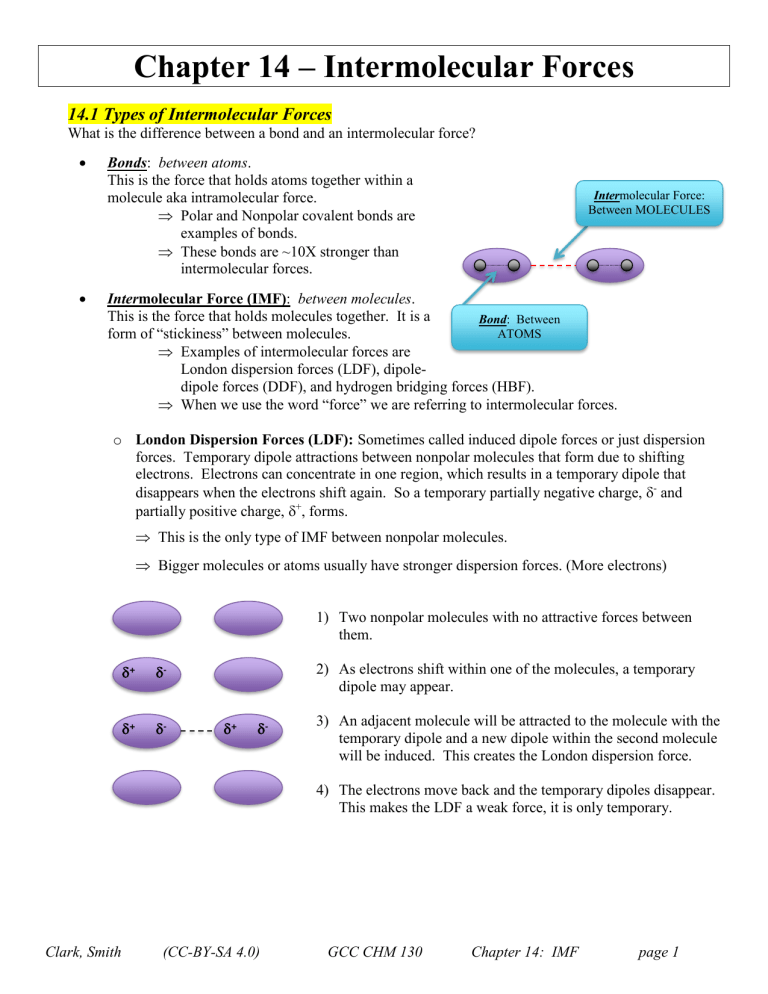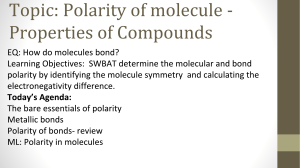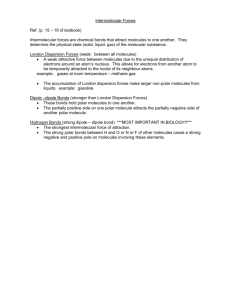
Chapter 14 – Intermolecular Forces 14.1 Types of Intermolecular Forces What is the difference between a bond and an intermolecular force? • • Bonds: between atoms. This is the force that holds atoms together within a molecule aka intramolecular force. Polar and Nonpolar covalent bonds are examples of bonds. These bonds are ~10X stronger than intermolecular forces. Intermolecular Force: Between MOLECULES Intermolecular Force (IMF): between molecules. This is the force that holds molecules together. It is a Bond: Between ATOMS form of “stickiness” between molecules. Examples of intermolecular forces are London dispersion forces (LDF), dipoledipole forces (DDF), and hydrogen bridging forces (HBF). When we use the word “force” we are referring to intermolecular forces. o London Dispersion Forces (LDF): Sometimes called induced dipole forces or just dispersion forces. Temporary dipole attractions between nonpolar molecules that form due to shifting electrons. Electrons can concentrate in one region, which results in a temporary dipole that disappears when the electrons shift again. So a temporary partially negative charge, - and partially positive charge, +, forms. This is the only type of IMF between nonpolar molecules. Bigger molecules or atoms usually have stronger dispersion forces. (More electrons) 1) Two nonpolar molecules with no attractive forces between them. + - + - 2) As electrons shift within one of the molecules, a temporary dipole may appear. + - 3) An adjacent molecule will be attracted to the molecule with the temporary dipole and a new dipole within the second molecule will be induced. This creates the London dispersion force. 4) The electrons move back and the temporary dipoles disappear. This makes the LDF a weak force, it is only temporary. Clark, Smith (CC-BY-SA 4.0) GCC CHM 130 Chapter 14: IMF page 1 o Dipole-Dipole Forces (DDF): A permanent dipole force exists between polar molecules. Attractions form between the partially positive and partially negative ends of adjacent polar molecules. Image from www.en.wikipedia.org Dipole forces are usually stronger than dispersion forces since the dipoles are permanent. Only polar molecules can form dipole-dipole forces! + - + - + - Note: The opposite dipoles align themselves to create the attractive forces. o Hydrogen Bonding Forces (HBF): An especially strong dipole force exists between molecules containing H-F, H-O or H-N bonds. (These bonds are highly polar due to the large electronegativity difference.) Also called H Bridging Force sometimes. A very strong type of IMF between polar molecules. Hydrogen Bridging Forces Image: www.en.wikipedia.org o Ion-Dipole Forces (IDF): When an ionic compound such as NaCl dissolves in water, the water molecules arrange their oppositely charged dipole to be attracted to the fully charged ion, creating a very strong attractive force called an ion-dipole force. Between a polar molecule and a fully charged ion. The partial negative (-) charge on the water molecule is attracted to the fully charged positive sodium ion (Na+). The partial positive (+) charge on the water molecule is attracted to the fully charged negative chloride ion (Cl-). Image: www.en.wikipedia.org Clark, Smith (CC-BY-SA 4.0) GCC CHM 130 Chapter 14: IMF page 2 Electrostatic attractive forces that create the ionic bond in NaCl are ~10 times stronger than a single ion-dipole force that is created between the ion and water. Only if enough water molecules surround the ion creating many, many ion-dipole attractions can the water molecule pull the ion away from the ionic crystal lattice, dissolving the ionic compound. Image from "Salts", by OpenStax Anatomy and Physiology, CC-BY-NC-SA 4.0. Example. Indicate the strongest type of intermolecular force (LDF, DDF, HBF, or IDF) between the molecules in the following: Polar or Nonpolar? Strongest Intermolecular Force A. CO2 B. PF3 C. HF D. CH4 E. KBr in H2O Answers: A) nonpolar, LDF; B) polar, DDF; C) polar; HBF; D) nonpolar, LDF; E) polar, IDF Clark, Smith (CC-BY-SA 4.0) GCC CHM 130 Chapter 14: IMF page 3 Summary Bonds Ionic bond – holds metal/nonmetal ions together Polar Covalent Bond – e- shared unequally between nonmetals Nonpolar Covalent Bond – e- shared equally between nonmetals Forces London Dispersion – nonpolar molecules Dipole-dipole – polar molecules Hydrogen Bonding Force – H bonded to N or O or F within the molecule Ion-Dipole Force – a fully charged ion and a polar molecule. • Coulomb’s Law Review o Opposite charges attract according to Coulomb’s Law. S N S N Opposite Charges Attract S N N S Same Charges Repel o The electrostatic attraction between two charges is proportional to the charge magnitude (q) and inversely proportional to the distance (r) squared. o F = ke(q1q2 / r2) o Larger charge means stronger attraction! o Ionic bonds very strong cause charges are complete +1, +2, +3 charges. Like in NaCl. o Dipole-dipole IMF are much weaker because charges are much less than +1. o Remember polar bonds are only partially + and −. YouTube Video LDF: https://youtu.be/vwljR1Kwbao YouTube Video DDF: https://youtu.be/dmmy3OklX1Y YouTube Video HBF: https://youtu.be/wiUnLDoDIrs YouTube Video Summary of IMF’s: https://youtu.be/S8QsLUO_tgQ 14.2 How IMF’s affect Properties of Liquids Intermolecular forces (IMFs) influence various properties of liquids. o Vapor Pressure - The pressure exerted by gas molecules above a liquid. At the surface some molecules of a liquid have enough kinetic energy to break their attractive forces with neighboring molecules. These molecules escape from the liquid phase and form a gas above the surface of the liquid. If there’s a lid, pressure develops. In the picture to the right, which liquid has the weaker IMF? (A) because there is more gas meaning liquid (A) is breaking away from the liquid state easier than (B) thus the IMF must be weaker in (A) than (B). (A) molecules are less attracted to each other than in (B). Clark, Smith (CC-BY-SA 4.0) GCC CHM 130 Chapter 14: IMF page 4 Stronger intermolecular forces → lower vapor pressure ▪ stronger attractions are harder to break so less gas forms above liquid (B) Weaker intermolecular forces → higher vapor pressure ▪ weaker attractions are easier to break so more gas forms above liquid (A) o Boiling point (bp): Temperature at which a liquid changes to gas. Boiling occurs when the vapor pressure of a liquid equals the atmospheric pressure. Stronger intermolecular forces higher BP ▪ A higher boiling point means more energy is required to boil the liquid. Its harder for molecules to break away from each other due to strong attractions. Image: www.en.wikipedia.org o Surface tension: Attraction between surface molecules in a liquid. Attractive forces at the surface pull molecules inward causing surface molecules to be held more tightly. This is why liquids form beads or drops when sprayed. Stronger intermolecular forces higher surface tension ▪ Surface tension of water is high enough that bugs can walk on water. Image: www.en.wikipedia.org o Viscosity: the resistance of a liquid to flow. e.g. honey flows slowly high viscosity; gasoline flows rapidly low viscosity. Stronger intermolecular forces higher viscosity Image: CC BY-NC 2.0 https://www.flickr.com/photos/domir iel/8037178979 14.3 Properties of Water Electron dot formula for H2O: ✓ ✓ Two bonding electron pairs. Two non-bonding (lone) electron pairs. H2O has a bent molecular geometry with bond angle of < 109.5 • Water has highly polar O-H bonds: can dissolve ionic compounds and mix with other polar substances • Water has strong H bonding forces between molecules resulted in observed physical properties discussed below. Clark, Smith (CC-BY-SA 4.0) GCC CHM 130 Chapter 14: IMF page 5 Physical Properties of Water • Very polar, high IMF • High bp and mp: bp = 100 C, mp = 0 C • High surface tension, Low vapor pressure • Water expands as it freezes Density of ice is less than density of liquid water (rare) Molecular Crystal Structure of Ice. Hydrogen bridging forces attract the H2O molecules to one another as ice forms creating a larger volume. As a result the density of ice is less than the density of liquid water. Image from www.en.wikipedia.org Image of a snowflake. Viewed through an optical microscope. Image from www.en.wikipedia.org. 14.4 Heating-Cooling Curve Be able to indicate the following on a heating curve: • Regions for solid only, liquid only, gas only, solid-liquid, liquid-gas • Where melting, freezing, boiling, and condensation occur • Location of Melting point and Boiling point Gas Temperature (ºC) BP Liquid MP Solid Heat Added ☺ Clark, Smith (CC-BY-SA 4.0) GCC CHM 130 Chapter 14: IMF page 6 CHAPTER 14 PRACTICE PROBLEMS Example 1. Indicate the strongest type of intermolecular force (Dispersion, Dipole-Dipole or Hydrogen bond) between the molecules in the following: Polar or Nonpolar? Strongest Intermolecular Force A. CCl4 B. NH3 C. HCl D. OF2 Example 2. Choose the bond or attraction described for each below: IMFs are attractions between molecules. Bonds hold atoms together in a molecule. A. polar covalent bond E. dispersion force IMF? Y or N B. nonpolar covalent bond F. dipole-dipole force Type (A-G) C. ionic bond D. metallic bond G. hydrogen bonding force Description of bond or attractive force 1. What is holding the atoms together in an HF molecule 2. What is holding two Br2 molecules together in Br2(l). 3. What is holding the ions together in CuCl2. 4. What is holding two H2O molecules together. 5. What is holding the atoms together in a sample of Cu. 6. What is holding the atoms together in an O2 molecule. 7. What is holding two OF2 molecules together. Example 3. Water molecules experience hydrogen bonding while hexane molecules experience dispersion forces. Circle true or false for the following statements. A. Water’s intermolecular forces are weaker than hexanes. T F B. Hexane has a higher vapor pressure than water. T F C. Hexane has a lower boiling point than water. T F D. Water has a higher surface tension than hexane. T F E. Water has lower viscosity than hexane. T F F. Water has higher molar heat of vaporization than hexane. T F Clark, Smith (CC-BY-SA 4.0) GCC CHM 130 Chapter 14: IMF page 7 Answers to Practice Problems Example 1. Polar or Nonpolar? Strongest Intermolecular Force A. CCl4 Nonpolar Dispersion (or London) B. NH3 Polar H bond C. HCl Polar Dipole D. OF2 Polar Dipole Example 2. Choose the bond or attraction described for each below: A. polar covalent bond E. dispersion force B. nonpolar covalent bond F. dipole-dipole force C. ionic bond D. metallic bond G. hydrogen bonding force IMF? Y or N N Type (A-G) A 1. What is holding the atoms together in an HF molecule Y E 2. What is holding two Br2 molecules together in Br2(l). N C 3. What is holding the ions together in CuCl2. Y G 4. What is holding two H2O molecules together. N D 5. What is holding the atoms together in a sample of Cu. N B 6. What is holding the atoms together in an O2 molecule. Y F 7. What is holding two OF2 molecules together. Description of bond or attractive force Example 3: A False, B True, C True, D true, E false, F true Clark, Smith (CC-BY-SA 4.0) GCC CHM 130 Chapter 14: IMF page 8





